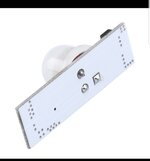zoxzox
Junior Member level 1

- Joined
- Sep 20, 2024
- Messages
- 18
- Helped
- 0
- Reputation
- 0
- Reaction score
- 0
- Trophy points
- 1
- Activity points
- 155
Hello everybody,
I would like to get my 1m led strip 12v to fade in/fade out when power supply is on/off. I have Mosfet IRLB8721, 100kohm resistor and 1000microfarad 16 volt capacitor. Can someone write me how to connect to those components to get fade on/fade out. Is it possible with these components at all? Is there any other simple diy way to make this fading?
Thanks
I would like to get my 1m led strip 12v to fade in/fade out when power supply is on/off. I have Mosfet IRLB8721, 100kohm resistor and 1000microfarad 16 volt capacitor. Can someone write me how to connect to those components to get fade on/fade out. Is it possible with these components at all? Is there any other simple diy way to make this fading?
Thanks



